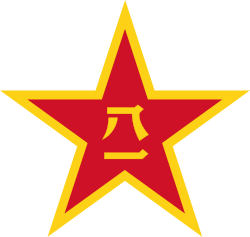IS tank family
| Iosif Stalin tank | |
|---|---|
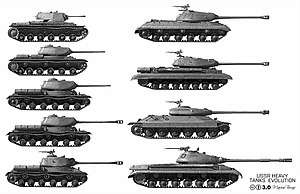 | |
| Type | Heavy tank |
| Place of origin | Soviet Union |
| Service history | |
| Used by | Soviet Union, China, Cuba, Czechoslovakia, DPRK, Egypt, Poland |
| Wars | |
| Production history | |
| Designer |
Zhozef Kotin Nikolay Dukhov |
| Designed |
|
| Manufacturer | Kirov Factory, UZTM |
| Unit cost | IS-2 Model 1944: 264,400 rubles[1] |
| Produced |
|
| No. built |
|
| Specifications (IS-2 Model 1944[2]) | |
| Weight | 46 tonnes (51 short tons; 45 long tons) |
| Length | 9.90 m (32 ft 6 in) |
| Width | 3.09 m (10 ft 2 in) |
| Height | 2.73 m (8 ft 11 in) |
| Crew | 4 |
|
| |
| Armor |
IS-2 Model 1944: Hull front: 100 mm at 60° angle Lower glacis: 100 mm at 30° angle Turret front: 100 mm (rounded) Mantlet: 155 mm (rounded) Hull side: 90–130 mm at 9-25° Turret side: 90 mm at 20° angle. |
Main armament | D25-T 122 mm gun (28 rounds) |
Secondary armament | 1×DShK, 3×DT (2,079 rounds) |
| Engine |
12-cyl. diesel model V-2 600 hp (450 kW) |
| Power/weight | 13 hp/tonne |
| Suspension | torsion bar |
| Fuel capacity | 820 l (180 imp gal; 220 US gal) |
Operational range | 240 km (150 mi) |
| Speed | 37 km/h (23 mph) |
The IS Tank was a series of heavy tanks developed as a successor to the KV-series by the Soviet Union during World War II. The heavy tank was designed with thick armor to counter German 88 mm guns and carried a main gun capable of defeating Tiger and Panther tanks. It was mainly a breakthrough tank, firing a heavy high-explosive shell that was useful against entrenchments and bunkers. The IS-2 went into service in April 1944 and was used as a spearhead by the Red Army in the final stage of the Battle of Berlin. The IS acronym is the anglicized initialism of Joseph Stalin (Ио́сиф Ста́лин, Iosif Stalin).
Design and production
Object 237 KV-85 and IS-85/IS-1
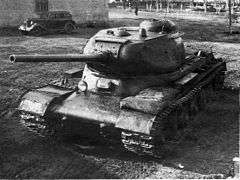
The KV-1 was criticized by its crews for its poor mobility and the lack of a larger caliber gun than the T-34 medium tank. It was much more expensive than the T-34, without having greater combat performance. Moscow ordered some KV-1 assembly lines to shift to T-34 production, leading to fears that KV-1 production would be halted and the SKB-2 design bureau, led by Kotin, closed.[3] In 1942, this problem was partially addressed by the KV-1S tank, which had thinner armor than the original, making it lighter and faster. It was competitive with the T-34 but at the cost of no longer having the heavier armor. Production of the KV-1S was gradually replaced by the SU-152[4] and ended in April 1943.[5]
The capture of a German Tiger tank in January 1943 led to a decision to develop a new heavy tank, which was given the codename Object 237.[6] Before Object 237 had time to mature, intense tank fighting in the summer of 1943 demanded a response. Dukhov's team was instructed to create a stopgap KV tank, the KV-85, which was armed with the 52-K-derivative gun of the SU-85, the 85 mm D-5T, that proved capable of penetrating the Tiger I from 500 m (550 yd). The KV-85 was created by mounting an Object 237 turret on a KV-1S hull. To accommodate the Object 237 turret, the KV-1S hull was modified, increasing the diameter of the turret ring with fillets on the sides of the hull. The radio operator was replaced with an ammunition rack for the larger 85 mm ammunition. The hull MG was then moved to the opposite side of the driver and fixed in place to be operated by the driver. From September to October 1943, a total of 130 KV-85s were produced, before the assembly lines began to shift over. Like the KV-1S, the KV-85 served in dwindling numbers and was quickly overshadowed by the superior IS series.[7]
The Object 237 prototype, a version of the cancelled KV-13, was accepted for production as the IS-85 heavy tank.[8] First deliveries were made in October 1943, and the tanks went immediately into service. Production ended in January 1944. Its designation was simplified to IS-1 after the introduction of the IS-122, later renamed as IS-2 for security purposes.[9]
Object 240 IS-2
Gun
By 1943, engineers had succeeded in mounting the 85 mm gun to the T-34 medium tank, making it as well-armed as the KV-85 heavy tank. Efforts to up-gun the IS-85 began in late 1943. Two candidate weapons were the D-25 122 mm tank gun, the ballistic characteristics of which were identical to the A-19 122 mm gun,[10] and the D-10 100 mm gun, which was based on a naval dual-purpose gun. The D-10 had been designed for anti-tank fire and had better armor penetration than the A-19, but the smaller caliber meant it had a less useful high explosive round. Also, the D-10 was a relatively new weapon in short supply, while there was excess production capacity for the A-19 and its ammunition. Compared to the older F-34 76.2 mm tank gun, the D-25 delivered 5.37 times the muzzle energy.
After testing both the D-25 and D-10 on the IS-122, the former was selected as the main armament of the new tank. The D-25 used a separate shell and powder charge, resulting in a lower rate of fire compared to the single-piece ammunition used in most tanks, a serious disadvantage in tank-to-tank engagements. Soviet proving-ground tests showed that the D-25 could penetrate the front armor of the German Panther tank at 2,500 m (2,700 yd) while the D-10 could do so at a maximum range of 1,500 m (1,600 yd).[10][11] It was therefore considered an adequate anti-tank gun.
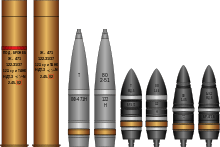
A Wa Pruef 1 Report dated 5 October 1944 has data on the penetration ranges of the 122 mm A-19 gun against a Panther tank angled at 30 degrees; this estimated that the A-19 gun was unable to penetrate the upper glacis plate of the Panther from any distance, could penetrate the lower glacis plate from 100 m (110 yd), could penetrate the mantlet from 500 m (550 yd) and could penetrate the front turret from 1,500 m (1,600 yd).[12] The Panther's 40–50 mm (1.6–2.0 in) thick side armor would have been exposed and vulnerable at such an angle; the sides at 30 degrees were penetrable from over 3,500 m (3,800 yd) according to the same Wa Pruef 1 report.[12] Testing with captured Tiger Ausf Bs in Kubinka showed that the 122 mm D-25T was capable of penetrating the Tiger Ausf B's turret from 1,000–1,500 m (1,100–1,600 yd) and the weld joint or edges of the front hull plates at ranges of 500–600 m (550–660 yd).[13] In 1944, the BR-471 was the sole armor-piercing round available. An improved version, the BR-471B (Russian: БР-471Б) was developed in spring 1945, but was available in quantity only after World War II ended.[14]
According to the same Wa Pruef 1 report, it was estimated that at 30 degree obliquity the hull armor of the Soviet IS-2 model 1943 would be defeated by Tiger I between 100 and 300 m (0.062 and 0.186 mi) at the driver's front plate and nose,[15] while the IS-2's 122 mm gun would penetrate the Tiger's front armor from between 500 and 1,500 m (0.31 and 0.93 mi).[15] A Panther had to close to 600 m (660 yd) to guarantee penetration of the IS-2's frontal armor (The Panther's 75 mm gun could penetrate the IS-2 model 1943's mantlet from 400 m (440 yd), front turret from 800 m (870 yd), and driver's front plate from 600 m (660 yd)[16]), while the IS-2 could penetrate the Panther at ranges of 1,000 m (1,100 yd).[17][Notes 1] However, in the summer of 1944, the Germans experienced a shortage of manganese and had to switch to using high-carbon steel alloyed with nickel, which made armor very brittle, especially at the seam welds. The performance of the 122 mm AP shells of the IS-2 against the Panther improved considerably. The reports from the front described cases where the BR-471 APHE round 122 mm projectile fired from 2,500 m (2,700 yd) ricocheted off the front armor of a Panther, leaving huge breaches to it.[18] According to Steven Zaloga, the IS-2[17] and Tiger I could knock each other out in normal combat distances below 1,000 m (1,100 yd). At any range, the performance of each tank against each other was dependent on the crew and combat situation.[19]

The large 122 mm HE shell was its main asset, proving highly useful and destructive as an infantry-killer. In extremis, the IS-2 engaged enemy heavy armor with OF-471 (Russian: ОФ-471) high explosive projectiles. These shells had a mass of 25 kg (55 lb), a muzzle velocity of 800 m/s (2,600 ft/s), and were equipped with a 3.8 kg (8.4 lb) TNT charge. The explosive power could blow off an enemy tank turret, drive sprocket and tread of the heaviest German tank even if it could not penetrate the armor.[20][21][20][21] Mechanical shock and explosion was often enough to knock out enemy heavy tanks.[20]
The most recognizable disadvantage of the D-25T gun was its slow rate of fire due to the large size and weight of the shells; only one to one and a half rounds per minute could be fired, initially.[22] After some design improvements, including a semi-automatic drop breech over the previously manual screw breech, the rate of fire increased to 2–3 rounds per minute.[22], and according to other sources, the increase may have amounted to 3–4 rounds per minute.[23] Another limitation imposed by the size of its ammunition in a relatively small vehicle was the ammunition stowage: only 28 rounds could be carried inside the tank, with a complement of 20 HE rounds and 8 AP rounds the norm.[24][25]
Production
The IS-122 prototype replaced the IS-85 and began mass production as the IS-2. The 85 mm guns could be reserved for the new T-34-85 medium tank and some of the IS-1s built were rearmed before leaving the factory and issued as IS-2s. It was slightly lighter and faster than the heaviest KV model 1942 tank, with thicker front armor and a much-improved turret design. The tank could carry thicker armor than the KV series, while remaining lighter, due to the better layout of the armor envelope. The KV's armor was less well-shaped and featured heavy armor even on the rear, while the IS series concentrated its armor at the front. The IS-2 was slightly lighter than the Panther, much lighter than the Tiger I and Tiger II and had a lower silhouette than both. Western observers tended to criticize Soviet tanks for their lack of finish and crude construction. The Soviets argued that it was warranted, considering the need for wartime expediency and the typically short battlefield life of their tanks.[26]
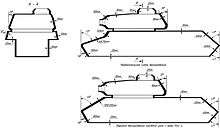
Early IS-2s can be identified by the 'stepped' front hull casting with its small, opening driver's visor. The early tanks lacked gun tube travel locks or anti-aircraft-capable machine guns and had narrow mantlets.
In late 1944, the stepped hull front was replaced with an improved single casting of 120 mm thickness angled at 60 degrees. This new nose lacked the opening driver's visor. It is sometimes incorrectly referred to as the IS-2M, but that designation actually refers to a much later modernization program from the 1950s. Other minor upgrades included the addition of a travel lock on the hull rear, wider mantlet and, on very late models, an anti-aircraft machine gun.
In comparison to the Tiger I, the IS-2 had modest advantages in armour, even though it was 10 tons lighter[27]
In the mid-1950s, the remaining IS-2 tanks (mostly model 1944 variants) were upgraded to the IS-2M standard, which introduced fittings such as external fuel tanks on the rear hull (the basic IS-2 had these only on the hull sides), stowage bins on both sides of the hull and protective skirting along the top edges of the tracks.
Object 703 IS-3

There are two tanks known as IS-3: Object 244 was an IS-2 rearmed with the long-barrelled 85 mm cannon (D-5T-85-BM) and developed by LKZ (in Leningrad), which was never series-produced for service use.
Object 703 was developed in late 1944 by ChTZ (in Chelyabinsk) and left the factory shop in May 1945.[28] This tank had an improved armour layout, and a semi-hemispherical cast turret (resembling an upturned soup bowl), which became the hallmark of post-war Soviet tanks. While this low, hemispherical turret improved protection, it also significantly diminished crew headroom, especially for the loader. The low turret also limited the maximum depression of the main gun, since the gun breech had little room inside the turret to elevate, and this limited the extent to which the IS-3 could take advantage of hull-down positions.[29] The IS-3's pointed prow earned it the nickname Shchuka (Pike) by its crews. It weighed slightly less and stood 30 centimetres (12 in) lower than previous versions. Wartime production resulted in many mechanical problems and a hull weldline that had a tendency to crack open.[30]
The IS-3 came too late to see action in World War II. The first public demonstration of the IS-3 came on 7 September 1945 during the Allied victory parade on Charlottenburger Straße in Berlin, with the heavily reinforced 71st Guards Heavy Tank Regiment of the 2nd Guards Tank Army.[28] Starting in 1960, the IS-3 was slightly modernized as the IS-3M, in a manner similar to the IS-2M.
Object 701 IS-4
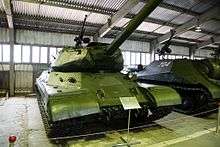
There are two tanks known as IS-4: Objekt 245 and Objekt 701. Objekt 245 was an IS-2 rearmed with a long 100 mm D-10T cannon. The other IS-4 was a new vehicle projected by LKZ in parallel with the IS-3 known as Objekt 701 by the same design and development bureau. For the latter, the IS-2 hull was lengthened, with an extra set of road wheels added and an improved engine. Both hull and turret armor were increased. Several alternative armaments were explored in paper studies but ultimately the IS-2's original 122 mm gun was retained. An effort was also made to make use of technical data derived from study of the German wartime Panzer V Panther tank, which influenced the layout of the Objekt 701's engine cooling system. The tank was approved for mass production from 1947 to 1949 but, due to disappointing speed and mobility, only 250 were built. Most of these were transferred to the Russian Far East. In 1949, production was cancelled and later these tanks were removed from service.
Object 252/253 IS-6
There existed two different IS-6s: the Object 253 was an attempt to develop a practical electrical transmission system for heavy tanks. Similar systems had been tested previously in France and the United States and had been used with some success in the German Elefant/Ferdinand tank destroyer during World War II. The experimental transmission proved unreliable and was dangerously prone to overheating, and development was discontinued. The alternative Object 252 shared the same hull and turret as the Object 253, but used a different suspension with no return rollers, and a conventional mechanical transmission. The design was deemed to offer no significant advantages over the IS-2, just the reload time was less, and the IS-6 project was halted.
Object 260 IS-7
The IS-7 heavy tank was developed in 1948.[31][32] Weighing 68 tonnes, thickly armoured and armed with a 130 mm S-70 long-barrelled gun, it was the largest and heaviest member of the IS family.[33]
The armour was engineered in a similar fashion to the IS-3, with a pike nose on the upper glacis. When shot at frontally, the extreme angle that the pike nose presents results in a much higher likelihood of a ricochet. Thus, the armour protection could be enhanced without having to use excessive amounts of materials. However, if the pike nose was shot at a sideways angle, it would not have a relative thickness high enough to ricochet the shell. In spite of its weight, it was easy to drive due to numerous hydraulic assists. The loaders noted that the IS-7 was comfortable and that the autoloader was easy to use. It was also able to achieve a top speed of 60 km/h thanks to a 1050-horsepower engine giving it a power to weight ratio of 15.4 hp/tonne, a ratio superior to most contemporary medium tanks. Its armour was not only immune to the Jagdtiger's 12.8 cm Pak 44 but was even proof to its own 130mm. Due to the reasons unknown, most likely because of the considerable issues arising from its mass (bridges, rail transport - no Soviet/Russian tank accepted into service afterwards exceeded 55 t), the tank never reached the production lines.[34]
Object 730 T-10
The IS-10[35] (also known as Objekt 730) was the final development of the KV and IS tank series. It was accepted into service in 1952 as the IS-10,[35] but due to the political climate in the wake of Stalin's death in 1953, it was renamed T-10.
The biggest differences from its direct ancestor, the IS-3, were a longer hull, seven pairs of road wheels instead of six, a larger turret mounting a new gun with fume extractor, an improved diesel engine, and increased armour. General performance was similar, although the T-10 could carry more ammunition.
T-10s (like the earlier tanks they replaced) were deployed in independent tank regiments belonging to armies, and independent tank battalions belonging to divisions. These independent tank units could be attached to mechanized units, to support infantry operations and perform breakthroughs.
The T-10M is the final iteration of this type. It featured a longer gun barrel than previous models with 5-baffle muzzle brake and 14.5 mm machine gun. This was the last Soviet heavy tank to enter service. When the advanced T-64 MBT became available it replaced the T-10 in front line formations.
Comparisons
| T-35 | T-100 | SMK | KV-1 M1940 |
KV-1 M1941 |
KV-1 M1942 |
KV-1S M1942 |
KV-85 M1943 |
IS-2 M1945 |
IS-3[37][38] M1945 | |
|---|---|---|---|---|---|---|---|---|---|---|
| Crew | 11 | 7 | 7 | 5 | 5 | 5 | 5 | 4 | 4 | 4 |
| Weight (tonnes) | 45 | 58 | 55 | 43 | 45 | 47 | 42.5 | 46 | 46 | 46.5 |
| Gun | 76.2 mm M. 27/32 |
76.2 mm L-11 |
76.2 mm L-11 |
76.2 mm F-32 |
76.2 mm F-34 |
76.2 mm ZiS-5 |
76.2 mm ZiS-5 |
85 mm D-5T |
122 mm D-25T |
122 mm D-25T |
| Ammunition | 100 | – | – | 111 | 111 | 114 | 114 | 70 | 28 | 28 |
| Secondary armament | 2×45 mm 5×7.62 mm |
45 mm | 45 mm | 2×DT | 4×DT | 4×DT | 4×DT | 3×DT | 3×DT, DShK | 2×DT, DShK |
| Engine | 500 hp M-17M gasoline |
500 hp | 850 hp AM-34 |
600 hp V-2K diesel |
600 hp V-2 |
600 hp V-2 |
600 hp V-2 |
600 hp V-2 |
600 hp V-2 |
600 hp V-2-IS |
| Fuel (litres) | 910 | – | – | 600 | 600 | 600 | 975 | 975 | 820 | 520 + 270 |
| Road speed (km/h) | 30 | 35 | 36 | 35 | 35 | 28 | 45 | 40 | 37 | 37 |
| Road range (km) | 150 | – | 150 | 335 | 335 | 250 | 250 | 250 | 240 | 150 (225) |
| Armor (mm) | 11–30 | 20–70 | 20–60 | 25–75 | 30–90 | 20–130 | 30–82 | 30–160 | 30–160 | 20–220 |
Combat history
The IS-2 tank first saw combat in early 1944. IS-2s were solely assigned to the Red Army's elite Guards Heavy Tank Regiments, with one regiment having a total of 21 IS-2 tanks, spread out across four individual companies that are provided with five tanks each, with the remaining one being used by the regimental commander.[39] These special tank regiments were reserved for specific combat purposes and major offensive operations. They were often employed to spearhead and lead tank attacks and to break through heavily-fortified German defensive positions ranging from anti-tank defence lines to solid bunkers.[39] Their role included supporting infantry in the assault and by using concentrated gunfire to destroy bunkers, buildings, dug-in crew-served weapons and other "soft" targets of the enemy. They were also capable of taking on and dealing with any German tanks and AFVs if required. Once a breakthrough past the tough enemy lines was achieved, lighter and more mobile tanks would take over the exploitation and mopping-up that would follow.
The IS-2 tank first saw action in the Ukraine in early 1944, and claimed to have destroyed more than 40 Tigers and Elefants for the loss of only eight tanks. While the German heavy tanks could knock out the IS-2, they had no real answer to its 122mm armament, which easily outgunned them.[40]
Oględów
On the morning of 11 August 1944, the 16th Panzer Division attacked the 53d Guards Tank Brigade reinforced by the 71st Independent Guards Heavy Tank Regiment in the town of Oględów, toward Staszów. The extremely sandy terrain forced the 11 King Tigers to stay primarily on the existing roads, whilst the defending Soviet forces positioned their tanks and assault guns in hidden ambush positions and focused on the known German avenues of approach.[41] During the initial attack that started, three King Tigers were destroyed by fire from Soviet IS-2 tanks, and one more King Tiger was knocked out during a subsequent attack a few hours later by a T-34/76 at a range of less than 400 meters. Later in the day, Soviet forces counter-attacked and seized the town of Oględów and found three abandoned King Tigers. The capture of the three operational King Tigers allowed the Soviets to conduct tests at Kubinka and to valuate its strengths and weaknesses.[42]
The next two day's fighting moved toward the town of Staszów. During several counterattacks, Heavy Tank Battalion 501 lost seven more King Tigers. Virtually all of these were destroyed by Soviet tanks occupying a defensive position against those German attacks.[43] Throughout three days of fighting, Soviet forces destroyed or captured 14[44] of 30 Tiger IIs to an approximately equal number of Soviet IS-2s and T-34s[45]
Lisów
On 12 January 1945, a column of Tiger IIs from the 524th Heavy Panzer Battalion were involved in a short-range engagement with IS-2 tanks near the village of Lisów (Poland), with both the German and Soviet formations suffering heavy losses.[46]
Post World War II
By the 1950s, the emergence of the main battle tank concept—combining medium-tank mobility with the firepower and armor of the heavy tank—had rendered heavy tanks obsolete. In the late 1960s the remaining Soviet heavy tanks were transferred to Red Army reserve service and storage. The IS-2 Model 1944 remained in active service much longer in the armies of Cuba, China and North Korea. A regiment of Chinese IS-2s was available for use in the Korean War, but saw no service there. In response to border disputes between the Soviet Union and China, some Soviet IS-3s were dug in as fixed pillboxes along the Soviet-Chinese border. The IS-3 was used in the 1956 Soviet invasion of Hungary and the Prague Spring in 1968.
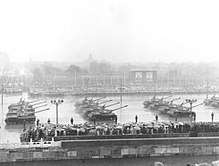
During the early 1950s, all IS-3s were modernized as IS-3M models. The Egyptian Army acquired about 100 IS-3M tanks from the Soviet Union.[47] During the Six-Day War, a single regiment of IS-3M tanks was stationed with the Egyptian 7th Infantry Division at Rafah and the 125th Tank Brigade of the 6th Mechanized Division at Kuntilla was also equipped with about 60 IS-3M tanks.[47] Israeli infantry and paratrooper units had considerable difficulty with the IS-3M when it was encountered due to its thick armor, which shrugged off hits from normal infantry anti-tank weapons such as the bazooka.[47] Even the 90 mm AP shell fired by the main gun of the Israeli Defense Force (IDF) M48 Patton tanks could not penetrate the frontal armor of the IS-3s at normal battle ranges.[47] There were a number of engagements between the M48A2 Pattons of the IDF 7th Armored Brigade and IS-3s supporting Egyptian positions at Rafah in which several M48A2s were knocked out in the fighting.[47]
However, in one engagement between a battalion of IS-3s and 90 mm gun-armed M48A3's, seven IS-3s were destroyed. The slow rate of fire, poor engine performance (the engine was not well suited to hot-climate operations), and rudimentary fire control of the IS-3s proved to be a significant handicap, and about 73 IS-3s were lost in the 1967 war.[47] Most Egyptian IS-3 tanks were withdrawn from service, though at least one regiment was retained in service as late as the 1973 October war.[47] The IDF itself experimented with a few captured IS-3M tanks, but found them ill-suited to fast-moving desert tank warfare; those that were not scrapped were turned into stationary defensive pillbox emplacements in the Jordan River area.[47]
After the Korean War, China attempted to reverse-engineer the IS-2/IS-3 as the Type 122 medium tank. The project was cancelled in favor of the Type 59, a copy of the Soviet T-54A.
Models
- KV-85
- A stopgap model built from a modified KV-1S hull mated to an Object 237(IS-1)'s turret and armed with the 85 mm D-5T.[48]
- IS-85 (IS-1)
- 1943 model armed with an 85 mm gun. When IS-2 production started, many were re-gunned with 122 mm guns before being issued.
- IS-100
- A prototype version armed with a 100 mm gun; it went into trials against the IS-122 which was armed with a 122 mm gun. Though the IS-100 was reported to have better anti-armor capabilities, the latter was chosen due to better all-around performance.
- IS-122 (IS-2 model 1943)
- 1943 model, armed with A-19 122 mm gun.
- IS-2 model 1944 (sometimes "IS-2m")
- 1944 improvement with D25-T 122 mm gun, with faster-loading drop breech and new fire control, improved simpler hull front.
- IS-2M
- 1950s modernization of IS-2 tanks.
- IS-3
- 1944 armor redesign, with new rounded turret, angular front hull casting, integrated stowage bins over the tracks. Internally similar to IS-2 model 1944, and produced concurrently. About 350 built during the war.
- IS-3M
- (1952) Modernized version of IS-3. Fitted with additional jettisonable external fuel tanks and improved hull welding.
- IS-4
- 1944 design, in competition against the IS-3. Longer hull and thicker armor than IS-2. About 250 were built, after the war.[49]
- IS-6
- Prototype with an experimental electrical transmission. Chassis tested further with a conventional transmission after failure of the experimental system, but not deemed a significant enough improvement over existing heavy tank designs to warrant mass production.[50]
- IS-7
- 1946 prototype, only three built. The IS-7 model 1948 variant had a weight of 68 metric tons and it was armed with the 130 mm S-70 naval cannon (7020 mm long barrel). The automatic loader can achieve up to 8 rounds per minute. Other equipment included stabilizers, infrared night scopes, and 8 machine guns. The hull armor was 150 mm placed at 50-52 degree angles. On the turret, the frontal thickness was 240–350 mm at an angle of 45-0 degrees. The IS-7 had a crew of five, with the driver in the hull, the commander and gunner in the front of the turret, with both loaders in the rear of the turret. A Slostin machine gun was to be installed as its AA armament.[33][34]
- IS-10
- [35] 1952 improvement with a longer hull, seven pairs of road wheels instead of six, a larger turret mounting a new gun with fume extractor, an improved diesel engine, and increased armor. Renamed T-10 as part of the Destalinization of the Soviet Union in the 1950s.
Operators
- People's Liberation Army: 60 IS-2s delivered in 1950–1951. Operated during the Korean War and in concrete bunkers along the Sino-Soviet border.
- Cuban Army: 41 IS-2Ms delivered in 1960.
- Czechoslovak Army: 8 IS-2/IS-2M in service between 1945-1960. Two IS-3 delivered in 1949 were used only for trials and military parades.
- NVA: 60 IS-2 delivered 1956. Operated until 1963.
- Egyptian Army: 100 IS-3M operated from 1956-1967, some in use in the Six-Day War 1967.
- Hungarian People's Army: 68 IS-2s in service between 1950-1956. After the crackdown of the Hungarian Revolution of 1956 all were returned to the Soviet Union.[52]
- IDF: Three IS-3M captured from Egypt in 1967. Reused as indirect fire artillery on the Sinai's Bar Lev line and as fixed turret bunkers fortifications along the Jordan Valley frontier.
- Korean People's Army: Small number of IS-2s; never deployed in combat in the Korean War.
- Polish Land Forces: Approximately 71 IS-2s used in combat between 1944-1945. 180 IS-2s survived as of 1955, and remained in service until the 1960s; some later were converted to armoured recovery vehicles. Two IS-3s were bought in 1946 for trials only.
- Romanian Land Forces: At least one IS-2 captured during May–June 1944.[53]
- South Ossetian Army: Operated some IS-2s, IS-3s and T-10s until 1995.
- Red Army: Heavy Breakthrough Tank from 1944-1945.
- Soviet Army: Phased out of service in the early-1970s.
- One IS-3, previously displayed on a pedestal in the village of Aleksandro-Kalynove near Kostiantynivka as a World War II memorial, used in combat by the Novorossiyan Armed Forces in the 2014 pro-Russian unrest in Ukraine.[54] Kostiantynivka was retaken by Ukrainian forces on 7 July 2014, along with the IS-3.[55][56]
Surviving vehicles
There are several surviving IS series tanks, with examples found at the following:
- IS-2
- Os. Górali [standing tank], Kraków, Poland
- Polish Army Museum, Warsaw, Poland
- Museum of Arms in Fort Winiary, Poznań, Poland
- Museum of Armoured Weapon in Training Center of Land Forces, Poznań, Poland (operational, see movie)
- Tank Museum of the People's Liberation Army, Beijing, China.
- Liberty Park, Overloon, The Netherlands.
- Museum of The History of Ukraine in World War II, Ukraine
- Kurzeme Fortress Museum, Zante, Latvia.
- Diorama Battle of Kursk, in Belgorod, Russia.
- The Collings Foundation, Stow, Mass., USA
- IS-2M
- Army Technical Museum, Lešany, Czech Republic[57] (previously in Prague as a Monument to Soviet tank crews)
- Imperial War Museum Duxford, England.
- Kubinka Tank Museum, Russia.
- Victory Park at Poklonnaya Gora, Moscow, Russia.
- IS-3
- IDF Armoured Corps Museum, Israel.
- Museum of Armoured Arms, Training Center of Land Forces, Poznań, Poland (still operational)
- Army Technical Museum, Lešany, Czech Republic (operational).[57]
- Polish Army Museum, Warsaw, Poland. (Fort Czerniaków branch of the Museum).
- National Armor and Cavalry Museum, Fort Benning, Georgia, United States.
- Victory Park in the northern part of Ulyanovsk, Russia.
- Ulyanovskoe SVU, Ulyanovsk, Russia
- Military Glory Museum, Gomel, Belarus.
- Diorama Battle of Kursk, in Belgorod, Russia.
- At least one IS-3 is being used by the separatist government in Donbass.
- IS-3M
- Egyptian National Military Museum, Cairo Citadel, Egypt.
- Military Vehicle Technology Foundation, California, United States.[58]
- Royal Museum of the Armed Forces and of Military History, Brussels, Belgium. (still operational)
- IS-4
- Kubinka Tank Museum, Russia.
- IS-7
- Kubinka Tank Museum, Russia.
Gallery
- IS-2
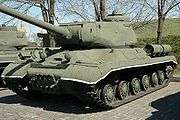 IS-2M
IS-2M IS-2M at the Kubinka Tank Museum
IS-2M at the Kubinka Tank Museum The IS-3 at the Military Technical Museum Lešany
The IS-3 at the Military Technical Museum Lešany.jpg) IS-3 heavy tank at the Museum Polskiej Techniki Wojskowej in Warsaw.
IS-3 heavy tank at the Museum Polskiej Techniki Wojskowej in Warsaw.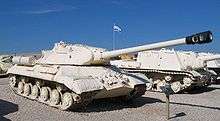 Former Egyptian Army IS-3M
Former Egyptian Army IS-3M
See also
- KV-1 heavy tank
- T-10 heavy tank
- ISU-152 assault gun
- ISU-122 assault gun
- List of Soviet tanks
- March of the Soviet Tankmen
Tanks of comparable role, performance and era
- German Tiger I heavy tank – comparable to IS-1/IS-85
- German Tiger II heavy tank – comparable to IS-2 model 1944 and IS-3
- United States M26 Pershing medium tank – comparable to IS-2 model 1944
- British Centurion heavy cruiser tank -comparable to IS-3/IS-4
- British Conqueror heavy tank designed after World War II - comparable to IS-7/Τ-10
- French AMX 50 prototype heavy tank – comparable to IS-2 model 1944 and IS-3/IS-4
Notes
- ↑ The German military intelligence journal for tank crews "Nachrichtenblatt der Panzertruppen Nr.12, June 1944 p. 34" reported that the IS-2 could be successful attacked at approximately 500 m (550 yd) at the angle of 30 degrees. This calculation was derived from firing tables "Pz. Beschusstafel" created against the KV-85. Steven Zaloga makes therefore an unfavorable comparison (30° to 90° for the range of destruction) for the Panther over its adversary
References
- ↑ http://tank.uw.ru/archive/sebestoimostx/
- ↑ Zaloga 1984, p 176.
- ↑ Zaloga 1994, p. 4.
- ↑ Zaloga 1996, p. 44.
- ↑ Zaloga 1996, p. 42.
- ↑ Zaloga 1994, p. 5.
- ↑ Zaloga 1996, p. 45.
- ↑ Zaloga 1994, p. 6.
- ↑ Zaloga 1994, p. 7.
- 1 2 Tolochkov; Volosatov (September 12, 1944). "Report on the results of testing of the 100 mm and the 122 mm tank guns at the Kubinka proving grounds". The Russian Battlefield. Retrieved 27 October 2014.
- ↑ Zaloga 1984:172
- 1 2 Jentz, Thomas (1995). Germany's Panther Tank: The Quest for Combat Supremacy. Schiffer Military History. p. 128. ISBN 0887408125.
- ↑ "Was the Tiger really King?". The Russian Battlefield. Retrieved 2014-10-24.
- ↑ David R. Higgins, "King Tiger vs IS-2: Operation Solstice 1945", p. 29
- 1 2 Jentz & Doyle 1993, pp. 19–20.
- ↑ Jentz 1995, p. 128
- 1 2 Zaloga, Steven (1994). IS-2 Heavy Tank 1944-73. Osprey. p. 12.
- ↑ "IS-1 and IS-2 Heavy tanks". The Russian Battlefield. 20 September 2005. Retrieved 2017-03-20.
source: Valery Potapov.
- ↑ Zaloga, Steven (1994). IS-2 Heavy Tank 1944–73. Osprey. p. 13.
- 1 2 3 Soviet Heavy Tanks: World War 2 In Review Special
- 1 2 The Encyclopedia of Weapons of World War II, Chris Bishop, P. 41
- 1 2 "D-25 Tank gun". The Russian Battlfield. Retrieved 6 November 2014.
- ↑ Zaloga, Steven (1994). IS-2 Heavy Tank 1944-73. Osprey Publishing Ltd. p. 41. ISBN 9781849084055.
- ↑ Zaloga 1984:175
- ↑ Higgins, David (2011). Kingtiger vs. IS-2. Osprey. p. 74. ISBN 9781849084055.
- ↑ Perrett 1987:20
- ↑ Zaloga, Steven (1994). IS-2 Heavy Tank 1944–73. Osprey. p. 25.
- 1 2 Russian armored vehicles. XX Century. Volume 3: 1945–1965 ISBN 5977101066, 2010. It must be noted nevertheless that Glantz and House assert the active presence of IS-3 tanks in the Jassy–Kishinev Offensive of August 1944. Cf. Glantz & House 2015, p. 282.
- ↑ Perrett 1987:21
- ↑ ZALOGA IS-2 HEAVY TANK 1944-73 P19
- ↑ "Советский тяжелый танк ИС-7 [IS-7 Soviet heavy tank]". Tankmuseum.ru. 2016-01-05. Retrieved 2016-02-21.
- ↑ "Heavy soviet tanks". Tankmuseum.ru. 1945-09-09. Archived from the original on May 22, 2011. Retrieved 2011-06-15.
- 1 2 Zaloga, Steven (1994). IS-2 Heavy Tank 1944-73. Osprey Publishing Ltd. p. 17. ISBN 1780961391.
- 1 2 Nikiforov, Alexei. "IS-7: the armored wonder?". PKKA CA. Retrieved 9 October 2014.
- 1 2 3 Miller 2000, p. 250.
- ↑ Zaloga & Grandsen (1984) pp. 119, 176
- ↑ IS-3 Model 1945 onwar.com
- ↑ The Cold War: A History by David Miller
- 1 2 Zaloga 1994, p. 8.
- ↑ Tiger I and Tiger II. Anthony Tucker-Jones. Pen and Sword, 2013. ISBN 1473826780. P 160
- ↑ Sledgehammers: Strengths and Flaws of Tiger Tank Battalions in World War II. Christopher W. Wilbeck. Aberjona, 2004. p.134
- ↑ Sledgehammers: Strengths and Flaws of Tiger Tank Battalions in World War II. Christopher W. Wilbeck. Aberjona, 2004. p.135
- ↑ Sledgehammers: Strengths and Flaws of Tiger Tank Battalions in World War II. Christopher W. Wilbeck. Aberjona, 2004. p.135
- ↑ Sledgehammers: Strengths and Flaws of Tiger Tank Battalions in World War II. Christopher W. Wilbeck. Aberjona, 2004. p.135
- ↑ Showalter, Dennis (2009), Hitler's Panzers: The Lightning Attacks that Revolutionized Warfare, Penguin, p. 315, ISBN 978-0425236895
- ↑ IS-2 Heavy Tank 1944–73. Steven J. Zaloga. Bloomsbury Publishing, 2011. p.24
- 1 2 3 4 5 6 7 8 Zaloga 1994, p. 39.
- ↑ Zaloga, Steven (1994). IS-2 Heavy Tank 1944-1944. Osprey Publishing Ltd. pp. 5–6. ISBN 1855323966.
- ↑ Zaloga, Steven (1994). IS-2 Heavy Tank 1944-73. Osprey Publishing Ltd. p. 20. ISBN 1780961391.
- ↑ Zaloga, Steven (1994). IS-2 Heavy Tank 1944-73. Osprey Publishing Ltd. p. 20. ISBN 1780961391.
- ↑ Das letzte Jahr der deutschen Heeres 1944-1945 " von Wolfgang Fleischer / Podzun-Pallas Verlag
- ↑ http://epa.oszk.hu/01600/01639/00008/pdf/EPA01639_elso_szazad_2012_tel_061-069.pdf
- ↑ Mark Axworthy, Cornel I. Scafeș, Cristian Crăciunoiu, Third Axis, Fourth Ally: Romanian Armed Forces in the European War, 1941-1945, p. 221
- ↑ "Танк "Иосиф Сталин-3" разгромил блокпост на Донбассе, есть погибшие" ["Joseph Stalin-3" tank crushed checkpoint in Donbass, fatalities]. RIA Novosti. 30 June 2014.
- ↑ "Ukrainian government troops target further gains". Market Watch (The Wall Street Journal). July 6, 2014.
- ↑ "Ukrainian flag raised over Kostiantynivka Town Council". ukrinform.ua.
- 1 2 Archived May 5, 2009, at the Wayback Machine.
- ↑ "Military Vehicle Technology Foundation - Collection by Category". Mvtf.org. Retrieved 2011-06-15.
Sources
- Baryatinsky, Mikhail (2006). The IS Tanks. Hersham, Surrey: Ian Allen Publishing. ISBN 0711031622; (13)9780711031623
- Glantz, David M.; House, DJonathan M. (2015). When Titans Clashed. How the Red Army Stopped Hitler (revised and expanded (Kindle) ed.). University Press of Kansas. ISBN 978-0-7006-2152-1.
- Jentz, Thomas (1995). Germany's Panther Tank: The Quest for Combat Supremacy. Atglen, PA: Schiffer Publishing. ISBN 0-88740-812-5
- Jentz, Tom; Doyle, Hillary (1993). Tiger 1 Heavy Tank 1942–45. illustrated by Sarson, Peter. Osprey. ISBN 978-1-85532-337-7.
- Perrett, Bryan (1987). Soviet Armour Since 1945. London: Blandford Press. ISBN 0-7137-1735-1.
- Sewell, Stephen ‘Cookie’ (2002). “Red Star – White Elephant?” in Armor, July–August 2002, pp 26–32. Fort Knox, KY: US Army Armor Center. ISSN 0004-2420
- Zaloga, Steven (1994). IS-2 Heavy Tank 1944-1973. Osprey Publishing. ISBN 978-1-85532-396-4.
- Zaloga, Steven (1996). KV-1 & 2 Heavy Tanks 1939–1945. Osprey Publishing. ISBN 978-1-8553-2496-1.
- Zaloga, Steven; James Grandsen (1984). Soviet Tanks and Combat Vehicles of World War Two. London: Arms and Armour Press. ISBN 0-85368-606-8.
- Железный марш [Iron March] (in Russian). ww2.kulichki.ru.
External links
| Wikimedia Commons has media related to Iosef Stalin tank. |
- Battlefield.ru: JS-1 and JS-2 Development history, Combat employment, Comparison to German tanks, Stripping the JS-2 -top view, Stripping the JS-2 -bottom view, JS-3 History, Soviet Heavy Tanks Specification, Last Heavy Tanks of the USSR (JS-4 through JS-10, or T-10)
- OnWar: IS-1, IS-2, IS-3
- IS-2M Photobook (PDF)
- M.Baryatinsky. History of IS-2 tanks (Russian)
- Picture of IS-2 bearing Polish markings.
- http://the.shadock.free.fr/Surviving_IS2.pdf. Retrieved 22/3/2008. Provides the location as well as photographs of surviving IS-2 tanks.
- IS-7 model 1948
- IS tanks, in museums and monuments.
- IS-3 "test drive" (video)
- AWACS Tank Guide: IS-7 - Beginner's Guides & Tutorials
